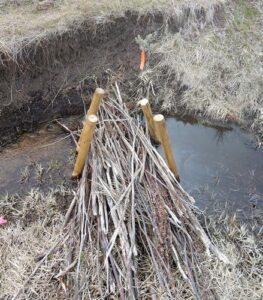Trust Idaho learn only part of the lesson about beaver dam analogues. They have noticed that the little dams produce really really good results for soil and fish, and have decided that the secret to having them is just to get many many people to make them by hand. Because as we have learned this year from nearly every media outlet, only human made beaver dams benefit fish and only relocated beavers can help save us from climate change.
Seriously.
Researchers try to copy beaver dam benefits
 Researchers are testing artificial beaver dams as a tool to restore degraded stream systems by improving riparian habitat and bolstering the late-season water supply.
Researchers are testing artificial beaver dams as a tool to restore degraded stream systems by improving riparian habitat and bolstering the late-season water supply.
The structures, known as beaver dam analogs, cause water to pool and spill beyond stream banks, supporting marshland vegetation before seeping into the groundwater and re-emerging downstream later.
Material such as willow boughs, sediment and stone comprise the analogs, an option to restore habitat where resources are insufficient to support beavers or where the animals would pose a nuisance.
A team of researchers from University of Idaho’s College of Agricultural and Life Sciences and College of Natural Resources is entering the final year of a three-year study of the concept, funded with a $75,000 grant from USDA Natural Resources Conservation Service.
75000 is a lot of money just for playing in the water! And you can bet they’ll keep right on trapping beavers while they do it. Because those rodents can seriously mess things up!
The project is bringing the colleges “to ask some of these important social and ecological questions,” Eric Winford, who is leading the project as his dissertation for a doctorate in natural resources, said in a UI release. “Across the West, we can restore some of the function beavers were maintaining in these systems by mimicking their activity.”
“There are potentially hundreds of miles of these meadows throughout the state where these could be applied,” he said.
The intermittent Guy Creek, within UI’s Rinker Rock Creek Ranch in central Idaho’s Wood River Valley, is the research site.The creek at the project’s start flowed through a deep channel disconnected from riparian areas.
Riparian vegetation can be essential for livestock, providing a verdant source of late-season forage, UI said.
Well Joe Wheaton says that this is how it starts. Get some BDA’s on the landscape and let people see what a dramatic effect they have and then when they come back complaining about maintaining them quietly remind them of the B word.
In July 2020, a group of recent high school graduates with the Idaho Conservation Corps helped the team build 65 analogs in three meadows.
The team has been using drones to evaluate gradual changes in the channel. Pools and riffles are forming, and sediment is accumulating behind the structures. Eventual gains in groundwater levels are expected as well as improvements in natural processes such as nutrient cycling.
Researchers anticipate that their stream gauges and groundwater monitoring will show the analogs build up groundwater and hold water until it is needed without curbing flows to downstream users, UI said. The state Department of Water Resources, which is interested in the research, requires anyone who installs a beaver dam analog to get a permit.
“In the lower two meadows we’ve been able to collect water samples later in the season from more pools than the year before,” said Laurel Lynch, College of Ag soil and water systems assistant professor. “It’s too early to say definitively that water levels are increasing, but it does seem anecdotally we’re pushing the system in that direction.”
She and her graduate students also are evaluating how riparian restoration influences water quality, soil carbon, microbial ecology and soil micro-invertebrate density.
That so weird, when we pay for students to make these little obstructions in the water we get more bugs and more soil and more birds and more fish and more otters. It’s such a coincidence! Can we get more students?
The team plans to host field days and workshops at Rinker Rock Creek Ranch, for public land managers and landowners.
Other College of Natural Resources team members include Jason Karl, the Harold F. and Ruth M. Heady Endowed Chair of Rangeland Ecology; and Charles Goebel, head of the Department of Forest, Rangeland and Fire Sciences.
Other College of Ag team members include Melinda Ellison, an assistant professor and Extension specialist focused on the effects of raising livestock on wildlife and range; Ellen Incelli, a graduate student studying environmental science; and Heather Neace, a graduate student studying water resources science and management.
Well I wasn’t born yesterday. I know it takes a man from Idaho to teach anyone from Idaho anything. Don’t listen to me about the workers you should really be enlisting in this effort. What do I know in my crazy golden state. Listen to Jay instead.






































